This document is a case study on Amazon's supply chain management, detailing the company's innovative strategies that have revolutionized the retail sector. It covers key components such as Amazon's fulfillment by Amazon (FBA), fulfillment centers, and delivery fleet, highlighting their role in enhancing efficiency and customer experience. The document also discusses future expectations, including potential advancements in automation and logistics.
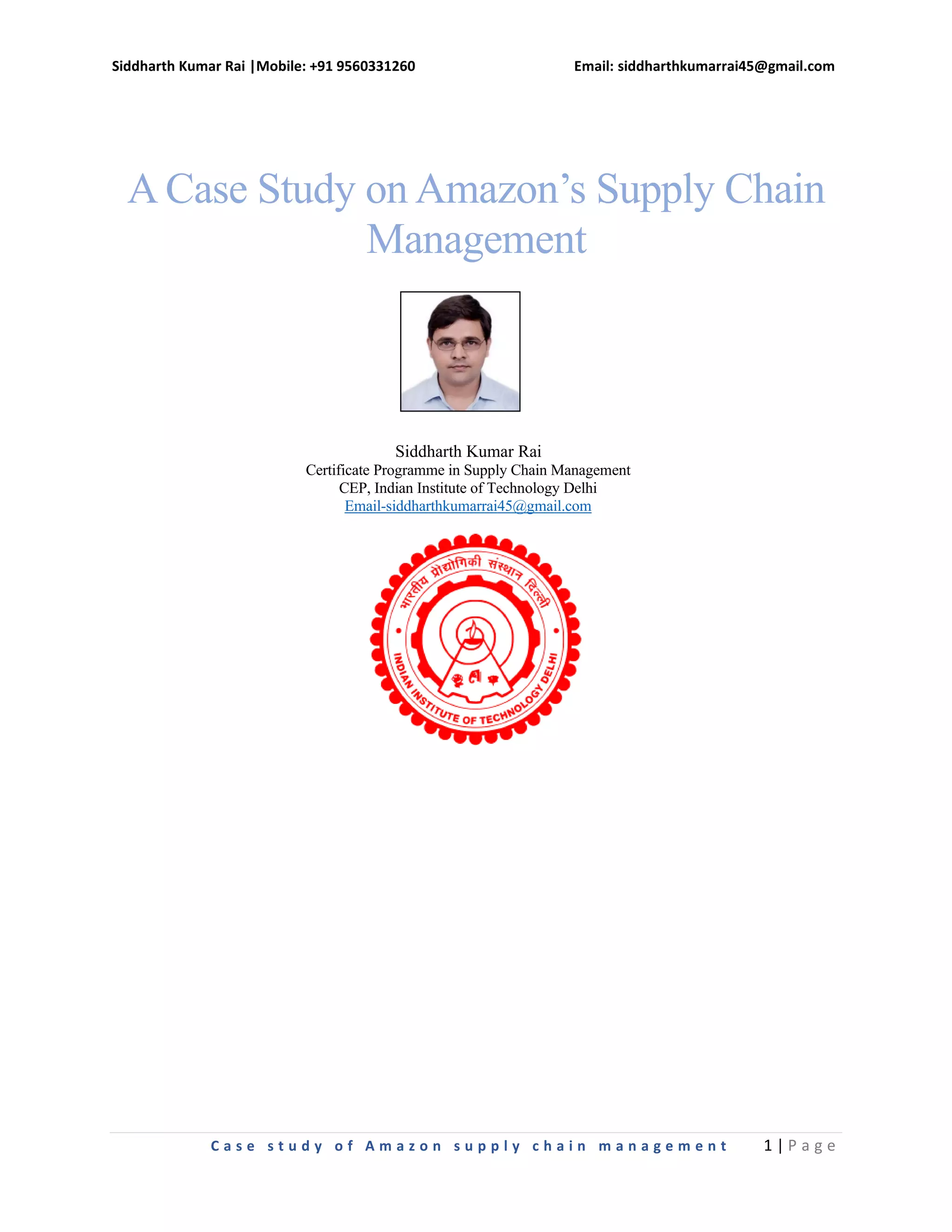

![Siddharth Kumar Rai |Mobile: +91 9560331260 Email: siddharthkumarrai45@gmail.com
C a s e s t u d y o f A m a z o n s u p p l y c h a i n m a n a g e m e n t 3 | P a g e
1. Introduction
Amazon has changed the face of retail through its use of bold supply chain strategies and the deployment
of innovative technologies. The online retailer's history is one of rapid growth and relentless innovations.
It's reshaping the supply chain and leaving competitors scrambling to catch up.
In 2004, 10 years after Amazon was founded, its annual revenue was just under $7 billion. According to
Statista, by 2018, revenue reached almost $233 billion. [1] In fact, Amazon is the fastest company to
reach $100 billion in sales revenue, taking only 20 years. [2] From its inception, Amazon has been
growing approximately 20% per year. It grew by over 20% from 2018 to 2019. [3] Currently, it enjoys
nearly 14% of gross global e-commerce sales.[4] Many believe Amazon is aiming for $1 trillion in yearly
revenue. If you take Amazon’s roughly 20% yearly growth rate into the calculation, it should reach that
goal by 2027.
Whether or not the company achieves that goal by then, its transformation from a simple online
bookseller to the most formidable force in the retail industry is remarkable. One of the driving forces
behind that transformation is its innovative and highly efficient supply chain. Amazon’s continuous
efforts to deliver products to the customers in the shortest possible time are putting intense pressure on
other retail industry giants across the globe and thus changing the way supply chain management works
Figure 1: Amazon's Incredible Long-Term Growth (https://www.statista.com/chart/4298/amazons-long-
term-growth/](https://image.slidesharecdn.com/casestudy-acasestudyofamazononitssupplychainmanagement-221106185926-95a586e1/75/Case-Study-A-case-study-of-Amazon-on-its-supply-chain-management-pdf-3-2048.jpg)
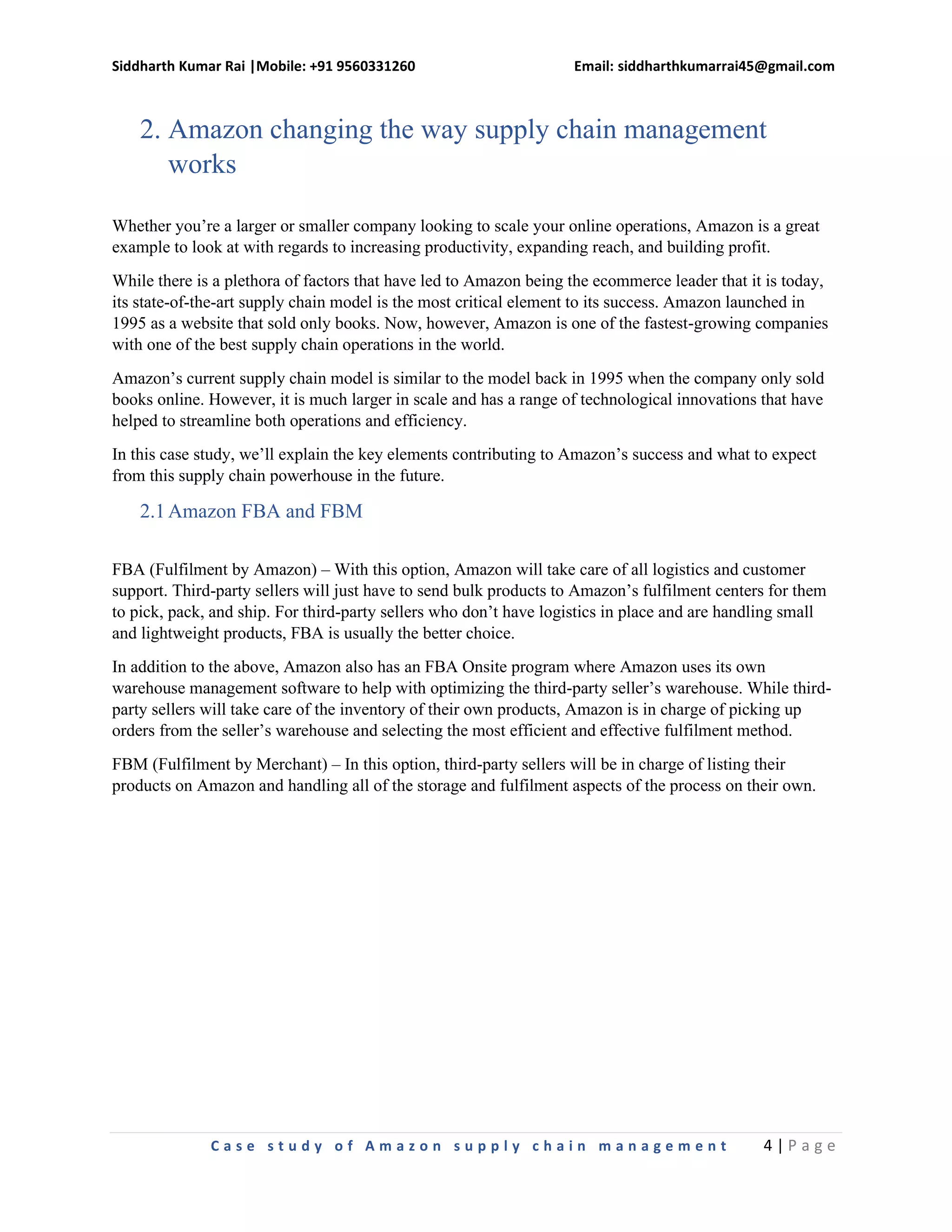



![Siddharth Kumar Rai |Mobile: +91 9560331260 Email: siddharthkumarrai45@gmail.com
C a s e s t u d y o f A m a z o n s u p p l y c h a i n m a n a g e m e n t 8 | P a g e
2. In 2014, Amazon introduced Sortation centres meant to improve “last mile delivery.” No
product is held at these locations. Instead, prepared customer packages move through conveyor
belts while Amazon associates and robots ‘sort and route the packages by zip code before they are
sent to a carrier for final delivery.
3. During 2020, Amazon opened several Delivery stations, the way that the company found to own
“last mile delivery” in its distribution system. These stations give Amazon flexibility in areas
with a high volume of orders.
4. Nowadays, Amazon are also investing in Amazon Prime Now hubs, the Amazon system for
time-sensitive items, like groceries, relies on Prime Now hubs. These hubs manage items that are
typically delivered within 2 hours of purchase.
The location, size, and number of warehouses are important factors in Amazon’s supply chain
success. Its warehouses are divided into five storage areas. Its library prime storage stores books and
magazines. Next, its pallet prime storage stores full-case products that have very high demand. Next,
case flow prime storage stores high-demand products picked in less-than-case quantities. Its reserve
storage accommodates irregularly shaped and low-demand products. Finally, its random storage area
stores smaller, moderate-demand items.
2.5Outsourcing Inventory Management and Insourcing Logistics
Amazon’s supply chain heavily depends on the outsourcing of its inventory management. Products that
are infrequently ordered are not stored in regular Amazon warehouses. It may come as a surprise to you
that third-party sellers are behind over 50% of Amazon’s sales.[5]
That amounted to over 3.4 billion products sold by third-party sellers in one year according to a May
2020 Amazon Report. [6]
Amazon’s two-hour or same-day shipping is possible due to its dependence on its own logistics. Amazon
understands too well that depending on third-party logistics to deliver these orders would just lengthen the
product delivery time. That’s why Amazon mostly uses its own delivery vehicles for same-day or one-
hour delivery options.
2.6Delivery Options for Customers
Amazon has different warehouses for different kinds of products and customer preferences. Prime
delivery, one-day delivery, first-class delivery, and free super-saver delivery are some of the common
delivery options available to Amazon customers. Amazon’s continuous efforts to meet every customer's
delivery preferences make it a logistics giant.
2.7Delivery Options for Customers
Amazon’s own warehouses are strategically placed and stocked, moving closer and closer to main
metropolitan areas and city centers. As a result, it uses a pure push strategy for the products it stores in its
warehouses, forecasting demand for the specific region. On the other hand, it uses a pure pull strategy
when it sells the products from third-party sellers, using more of an order-by-order fulfilment model.
2.8Classes and Zones
Amazon boasts 110 fulfilment centers in North America and almost 800,000 employees.7 To make good
on increasingly fast delivery promises, the company has positioned many new warehouses in proximity to
local urban markets. (Walmart's online strategy in China now similarly makes use of a closer-to-the-
customer fulfilment model, operating a network of mini-warehouses.)](https://image.slidesharecdn.com/casestudy-acasestudyofamazononitssupplychainmanagement-221106185926-95a586e1/75/Case-Study-A-case-study-of-Amazon-on-its-supply-chain-management-pdf-8-2048.jpg)

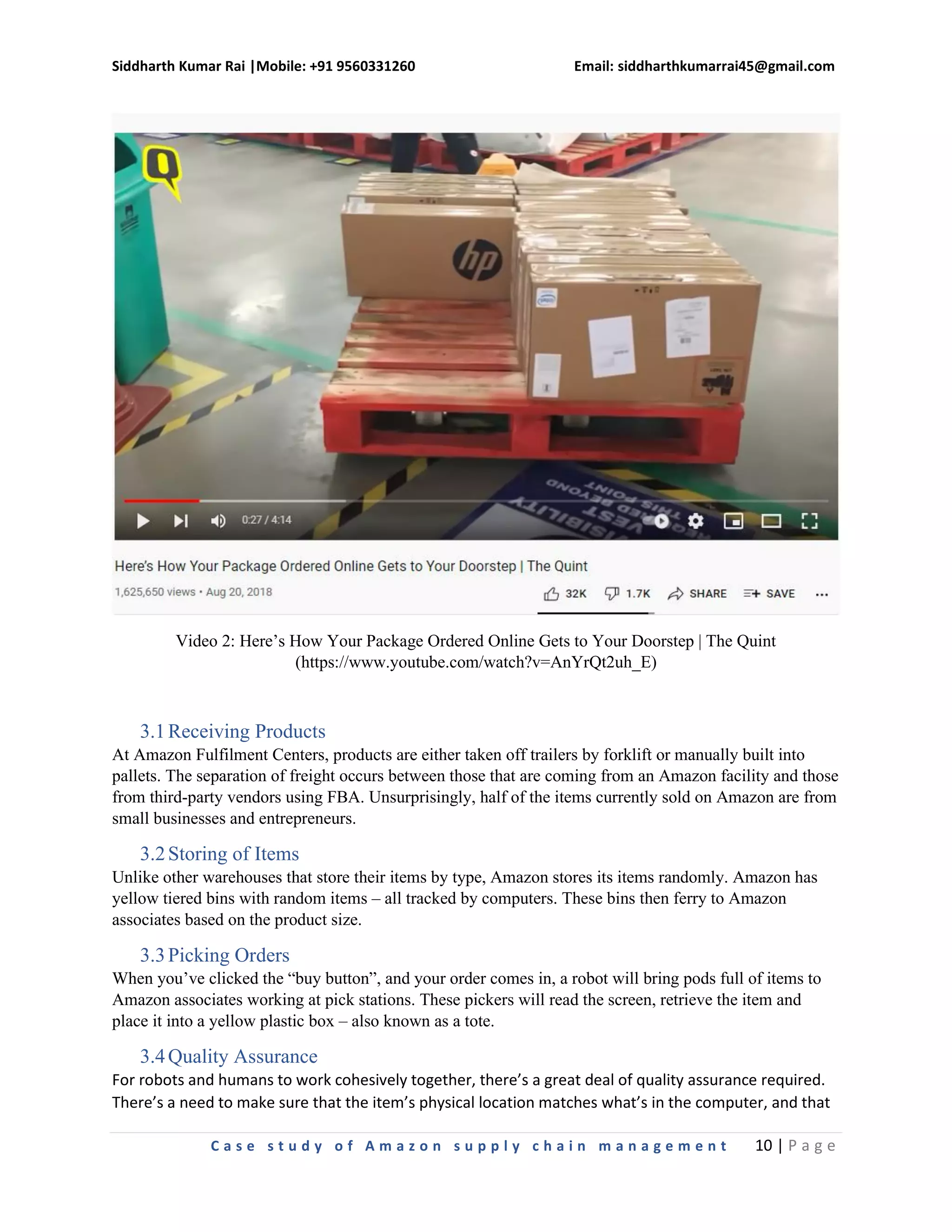

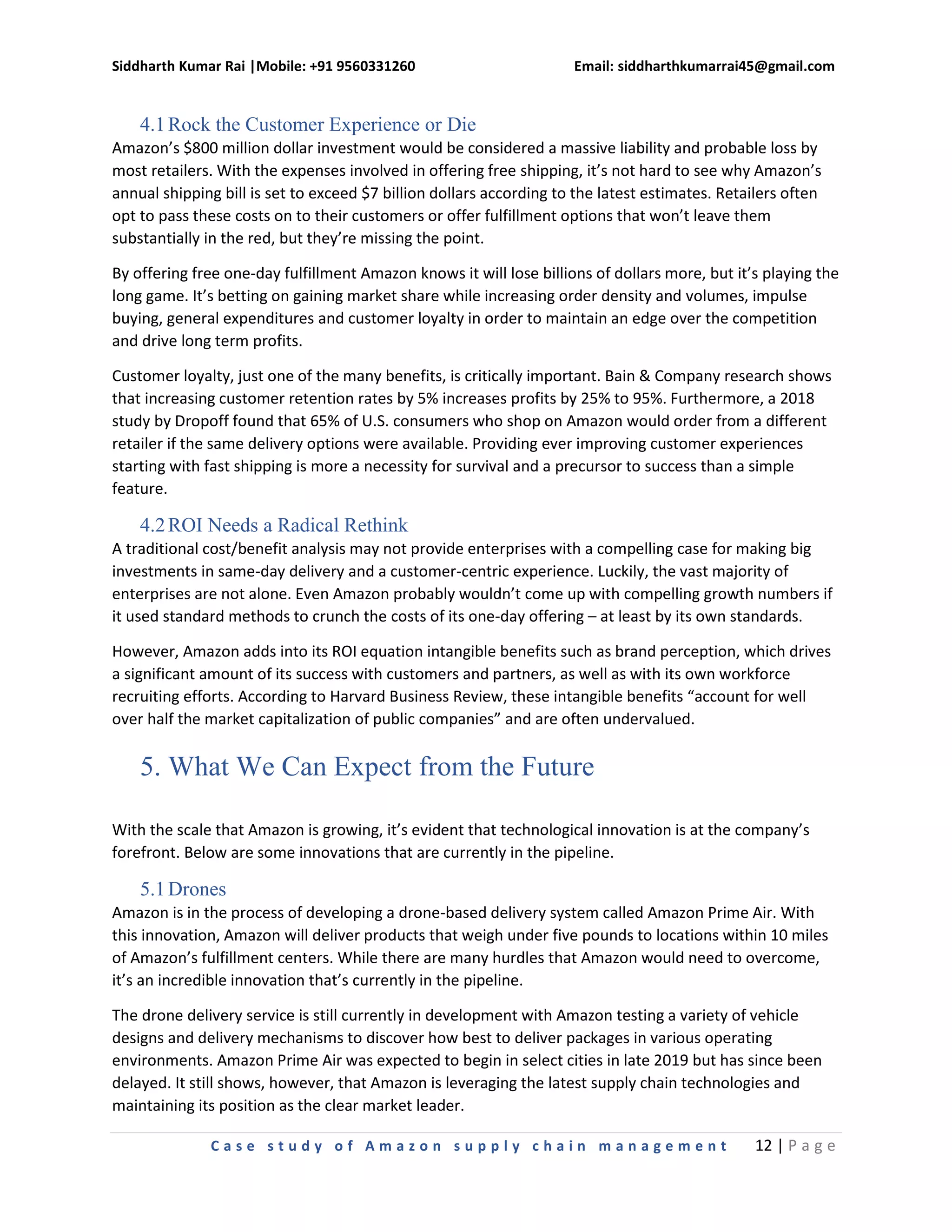
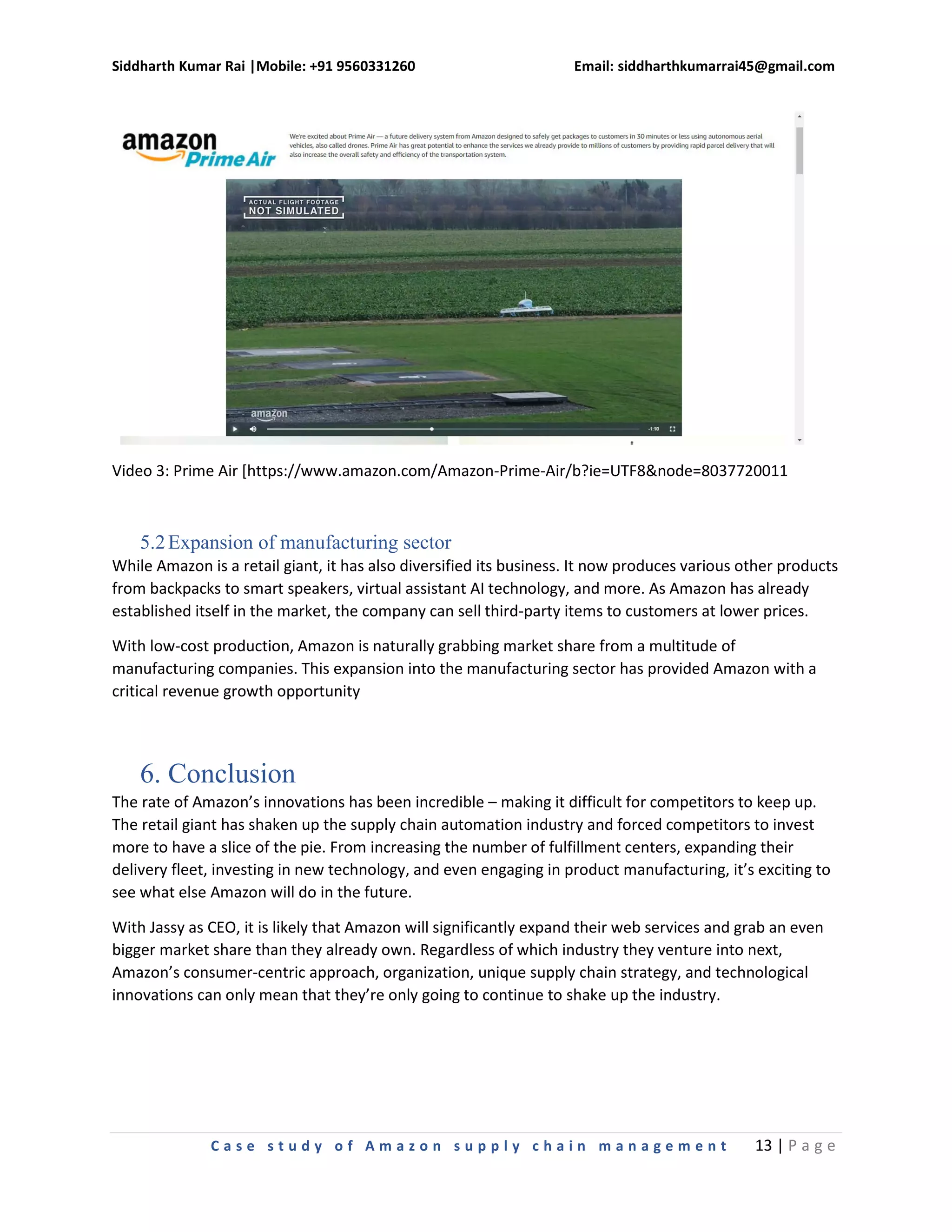
![Siddharth Kumar Rai |Mobile: +91 9560331260 Email: siddharthkumarrai45@gmail.com
C a s e s t u d y o f A m a z o n s u p p l y c h a i n m a n a g e m e n t 14 | P a g e
7. References
[1] Statisa. "Annual Net Revenue of Amazon From 2004 to 2019
[https://www.statista.com/statistics/266282/annual-net-revenue-of-amazoncom/]
[2] U.S. Securities and Exchange Commission. "Letter to Shareholders
[https://www.sec.gov/Archives/edgar/data/1018724/000119312516530910/d168744dex991.htm#:~:text=
To%20our%20shareowners%3A,than%20Amazon%20achieved%20that%20milestone.]
[3] CSIMarket. "AMZN's Revenue Growth by Quarter and Year
[https://csimarket.com/stocks/single_growth_rates.php?code=AMZN&rev]
[4] Statisa. "Global Retail E-Commerce Market Share of Amazon From 2016 to 2019
[https://www.statista.com/statistics/955796/global-amazon-e-commerce-market-share/]
[5] Statisa. "Percentage of Paid Units Sold by Third-Party Sellers on Amazon Platform as of 2nd Quarter
2020
[https://www.statista.com/statistics/259782/third-party-seller-share-of-amazon-platform/]
[6] Amazon. "Insights From the 2020 SMB Impact Report
[https://www.aboutamazon.com/news/small-business/small-business-success-in-challenging-times]
[7] Macrotrends. "Amazon: Number of Employees 2006-2020 | AMZN
[https://www.macrotrends.net/stocks/charts/AMZN/amazon/number-of-employees]](https://image.slidesharecdn.com/casestudy-acasestudyofamazononitssupplychainmanagement-221106185926-95a586e1/75/Case-Study-A-case-study-of-Amazon-on-its-supply-chain-management-pdf-14-2048.jpg)